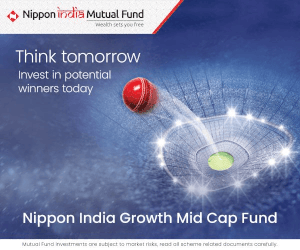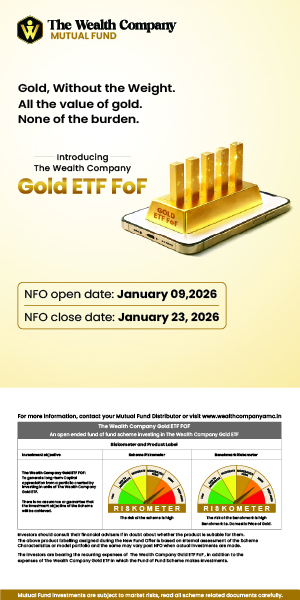It is a fund in which any class of investor can invest with a 3 plus years investment horizon
BFSI Industry Interview

Mr. Ritesh Jain is Senior Vice President and Head of Fixed Income at HSBC Global Asset Management India and his key responsibility include managing various fixed income funds. He has been working in the industry since 1998. Prior to joining HSBC in June 2019, Ritesh was a Partner and Head of Fixed Income at IIFL Asset Management Limited. His previous stints include DHFL Pramerica Asset Managers, Morgan Stanley Investment Management and Principal PNB Asset Management. On the educational front, Ritesh received a Post Graduate Diploma in Business Administration from K.J. Somaiya Institute of Management Studies and Research, Mumbai
India’s GDP contracted by nearly 24% in Q1. Fitch has forecasted India’s GDP to contract by more than 10% in FY 2020-21. What is your outlook on the Indian economy in the near (FY 21) to medium term?
Indian economy is currently in a tough phase. After seeing Q1 GDP contraction which is the highest among many leading economies, the near term outlook does look grim. However, our country had one of the strictest lockdowns and it has a highdependency on the unorganized sector. Putting all these things together, in a situation where economic activity is forced to a halt, the extent of contraction is not a shock. Therefore, with the economy opening up now, we believe that revival will set in gradually from hereon, albeit at a slower pace with growth in subsequent three Quarters remaining negative.Most of the analyst and economist projecting a 9-11% contraction for this fiscal and that is the consensus estimate now. We believe the worst is behind, and good monsoon and prospect of a strong harvest is positive for recovery even from the rural side. While the pandemic is not going away in a hurry, the related economic shock is weaning off, as the ambiguity relating to the nature of the pandemic is fading away. Also from a structural standpoint, we think that both at the government level and corporate level, the pandemic has been used as an opportunity to plug gaps in the business and operating environment or reshape the strategy in terms of necessary investments, cost rationalization, impetus on digital front – all of which are clear medium to long term positives.
What are views on bond yields, both Government and Corporate bonds?
There are multiple variables at play and the confluence of these determines the overall direction of the market. While the Growth outlook, Surplus liquidity in the system, Poor credit off take and RBI support to the market acting as the tail wind and remains supportive for the market, on the other hand we have - current inflation trajectory, the Fiscal outlook and thereby higher supply of Government Bond pulling the overall yield curve the other way. Out of these, it seems the liquidity and the RBI support to the market is what is acting as the prominent theme and driving the overall yield curve for now. On the sovereign front, while one cannot rule out the chances for a higher market borrowing than budgeted for, one can also expect RBI to step in to absorb supply and make sure that supply is not disruptive. Also, the pause in further easing in rates in the last policy was not a negative when the stance of the monetary policy remains accommodative and liquidity continue to remain at significant surplus mode. It is likely that in an environment where economy remains fragile and there is an overhang of fiscal supply, RBI will continue to do bulk of the heavy lifting. As such, we continue to maintain our constructive bias on yield and view yield curve to remain supported.
The corporate segment has been under pressure with credit events,ever since Aug 2018, post IL&Fs crisis. But the segment has recovered well on the back of liquidity mirroring G-sec trend. The credit environment is fragile and the chase for Quality remains intact. The drivers for Corporate bond performance – Surplus liquidity in the system, RBI support to the segment, weak credit off-take from banking system, growth in deposits and finally current steepness in the corporate curve which provide attractive carry over short-term funding cost remains positive for the segment. We particularly like the 3-5year part of the corporate curve and believe it to outperform going ahead. The longer end of the curve is more a function of rates and we will maintain our cautious stance on that part of the curve on account of high-volatility.
Are there attractive investment opportunities in corporate bonds, particularly high quality papers? Which parts of the yield curve are attractive from yield standpoint?
Attractive is a relative term, and we have to look at it from funding cost as well as quality perspective. Something at 6% yield could be attractive given its Risk/return profile while something at even 10% may not be attractive again given its risk profile. And we know quality always comes with a price. Having said so, we like the high quality(AAA/Sovereign), in the 3-5year segment of the corporate curve as we believe it scores on most of the risk/return parameter. The overall drivers for corporate bond remaining positive. Specifically, from risk parameter - the segment is moderate in duration risk, no compromise on credit quality and low volatility versus other long term investment avenues. And from return perspective, given the steepness in curve, we feel it is adequately compensating in form of spread and carry versus short-term funding cost. The segment remains attractive with the combination of accrual, spread pick-up and low volatility versus other long term products. We got to remember that because of surplus liquidity, the operating funding cost in the system is the Reverse-repo rate, which is currently at 3.35%, and that is the benchmark for asset pricing.
You are launching HSBC Corporate Bond Fund NFO. For the benefit of retail investors and financial advisors, please describe the salient features of this scheme?
The proposed corporate Bond Fund is for investors with an investment horizon of 3+ years and it is for those looking for a high credit quality portfolio with prospect to give optimum risk-adjusted market-linked returns. We are positioning the fund as an All season, Active, high quality(AAA/Sovereign) and moderate duration (3-5 year). The moderate duration strategy helps in avoiding undue volatility which is associated with Long duration products, while the Quality approach helps in avoiding any undue credit stress. The active management is likely to help in Alpha generation- primarily by way of identifying trade- off between cheaper and expensive assets within the AAA/ sovereign space and also duration management within the band in our endeavour to capture the prevailing attractive steepness (spread over short-term rates) in the curve. There are no exit-load and investors are free to move out of it anytime, if they feel that the fund is not up to their risk/return profile.
What is your duration strategy for this scheme?
As said, since we like the 3– 5years part of the curve, we intend to position there in terms of duration risk. The segment looks attractive to us on Risk/Return parameters and likely to yield desired Risk-adjusted returns. The positioning helps us in maintaining the moderate duration positioning along with indented pick-up over other short-term avenues of investment.
Given the experience over last couple of years, investors are concerned about credit risks. Even though Corporate Bond Funds invest primarily in high quality bonds, for the benefit of retail investors please share with us your credit risk appraisal and risk management processes?
Our credit selection process has been built on the premises of independent and comprehensive assessment of each and individual credit and it has only strengthened with time. Our Credit and Risk management process anyway is not structured for a particular environment, but to stand the test of time and different business cycles. We follow a rigorous credit selection process backed by fundamental research along with other parameters (tradability and liquidity of the asset). Each of the entity (credit) is approved via a credit discussion forum consisting of analyst, fund manager and CIO. For us, Risk Management is a continuous process and our approach toward Risk is proactive. There is a continuous ongoing evaluation and monitoring for market related, sector related or individual company related developments that helps us in identifying early-warning signal and take corrective action appropriately. As a practice, we have a complete demarcation in functions such as Fund Management, Credit Appraisal, Risk Management and Sales. Further, the categorization of exposure under different flags (White-Yellow-Red) depending upon the credit profile of the company is the incremental provision that has been incorporated in our Risk-Management framework. The Credit quality of our portfolio is reflective of the Quality First approach and our Credit & Risk Management framework.
Who should invest in HSBC Corporate Bond Fund? What is the minimum recommended investment tenure for this scheme? How should investors approach this scheme?
The proposed corporate Bond Fund is not targeted toward any specific set of investors. Rather, it is a fund in which any class of fixed income investor viz. retail, institutional, HNI can invest in with an investment horizon of 3+ years and it is for those looking for a high credit quality portfolio with prospect to give optimum risk-adjusted market-linked returns. With a 3+ year investment horizon, the indexation benefit is available which leads to a superior Post-tax returns for investors. It is comparable to any other investment avenues with similar risk and return profile and is likely to come out superior on the post-tax return analysis.

Mutual fund investments are subject to market risks, read all scheme-related documents carefully.
Recent Interviews
-
In conversation with Mr Pratik Oswal Chief of Passive Business of Motilal Oswal MF
Jan 6, 2026
-
In conversation with Mr Nilesh Jethani Fund Manager Equity with Bank of India Mutual Fund
Jan 6, 2026
-
Partner Connect by Advisorkhoj with Mr Amit Kalra Glorious Path Pvt Ltd New Delhi
Dec 5, 2025
-
Partner Connect by Advisorkhoj with Mr Alok Dubey PrimeWealth Pune
Dec 1, 2025
-
In Conversation by Advisorkhoj with Ms Aparna Shanker Chief Investment Officer Equity The Wealth Company Mutual Fund
Nov 28, 2025
Fund News
-
The Wealth Company Mutual Fund launches The Wealth Company Gold ETF FOF
Jan 9, 2026 by Advisorkhoj Team
-
Mahindra Manulife Mutual Fund launches Mahindra Manulife Innovation Opportunities Fund
Jan 9, 2026 by Advisorkhoj Team
-
Jio BlackRock Mutual Fund launches Jio BlackRock Short Duration Fund
Jan 8, 2026 by Advisorkhoj Team
-
Jio BlackRock Mutual Fund launches Jio BlackRock Low Duration Fund
Jan 8, 2026 by Advisorkhoj Team
-
Groww Mutual Fund launches Groww Small Cap Fund
Jan 8, 2026 by Advisorkhoj Team





